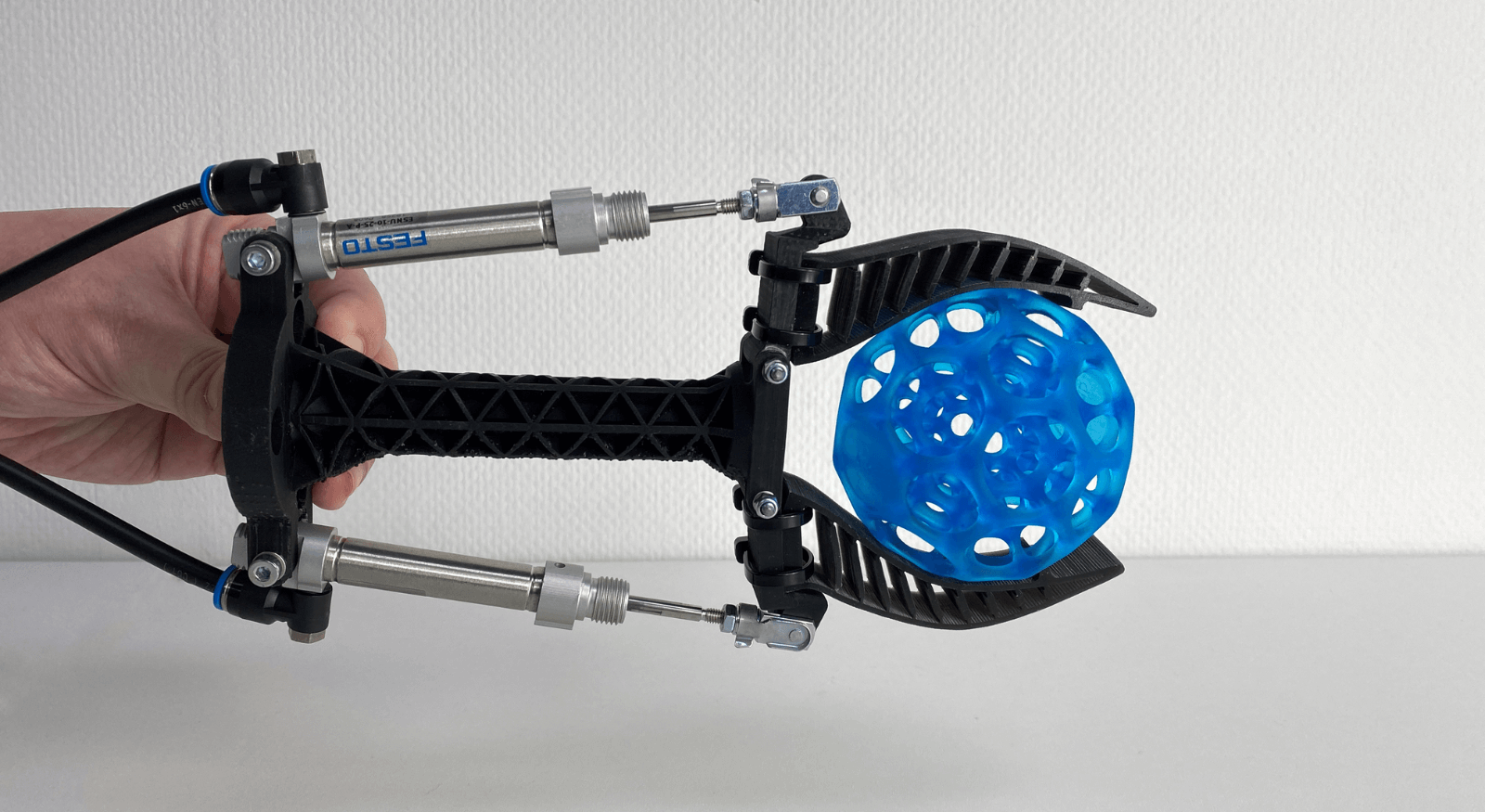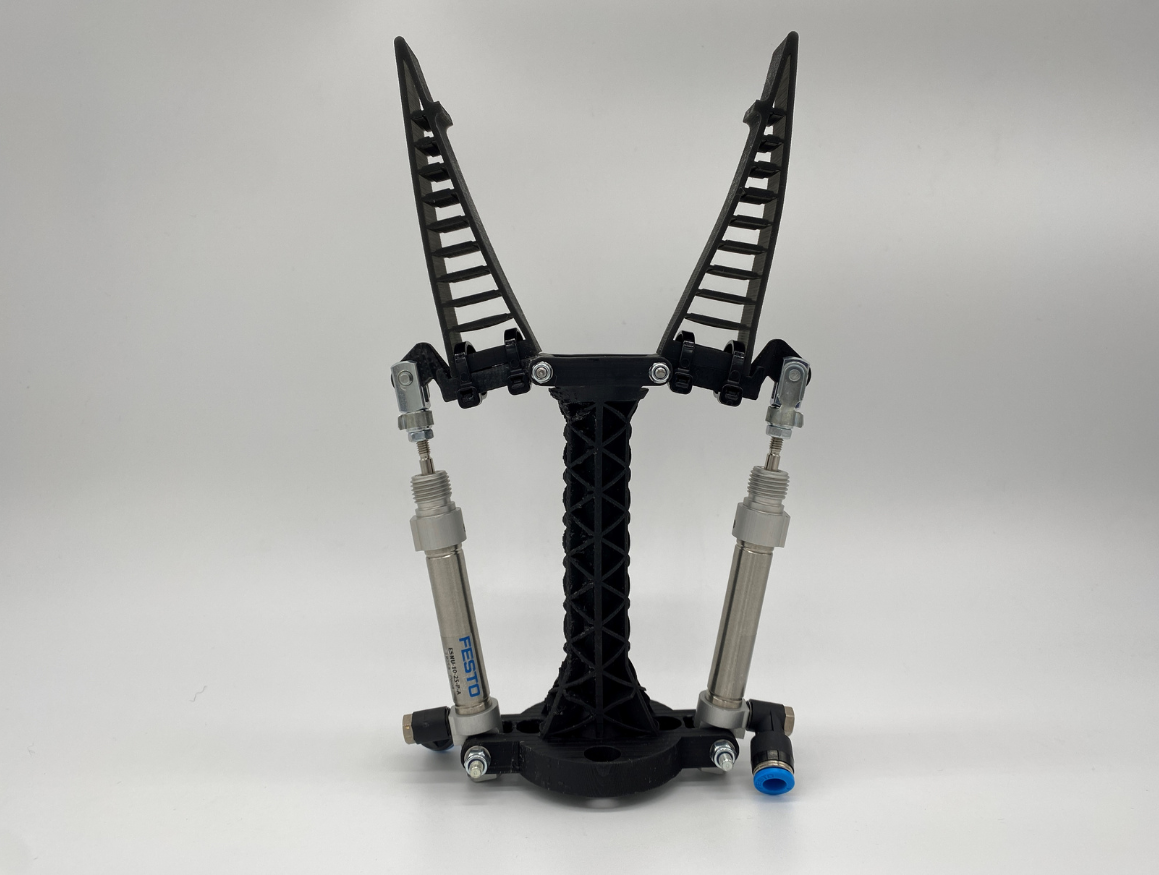How 3D printing is accelerating lead times for end-of-arm tooling
As production workflows become more and more automated, there is a continual reliance on soft end-of-arm tooling (EOAT) for robotic picking and assembly systems. These tools function as the interface between robots and products, ensuring parts are safely moved, supported, and manipulated without any scuffs or damages. Up until recently, urethane casting has been the method of choice for producing soft tooling, but additive manufacturing is now rising to the fore, offering manufacturers added value in terms of performance, lead times, and cost efficiency.
In this article we explore how soft tooling 3D printing works and how it can enhance end-of-arm tooling as well as other applications. We use examples and case studies from BASF Forward AM.
From Urethane Casting to Additive Manufacturing
For some time, a combination of urethane casting and CNC machining has been the norm for the production of soft tooling. Urethane rubber provides the durability, strength, and flexibility required by soft tooling applications, such as end-of-arm tooling and assembly fixtures, while CNC machining offers excellent tolerances.
Despite that, this approach has its challenges. For one, traditional soft tooling is a multi-step process that requires making a mold for the urethane, as well as a CNC machined base plate (typically made from metal), urethane CNC drilling and milling, and assembly. This results in long lead times, substantial material and labor costs, and heavy tools that weigh down robotic arms and can inhibit rapid movement.
With additive manufacturing in the picture, the game has changed. By leveraging 3D printing technologies, the right materials, and post-processing equipment, a significantly faster solution for producing soft tooling components can be achieved. Plastics manufacturer Extol has even developed its own process, called Soft Touch Tooling, which combines HP Multi Jet Fusion technology, BASF Forward AM Ultrasint® TPU powder, and AMT post-processing for direct soft tooling production.
The Soft Touch Tooling process works as follows: a base for the soft tool is printed using a more rigid material, such as PA11. The soft tool cap, designed to fit seamlessly onto the base, is then printed from Ultrasint® TPU01 material, a thermoplastic elastomer with rubber-like properties. AMT’s vapor smoothing post-process is then used to smooth and seal the TPU, making it easier to clean (a vital property for industrial settings where soft tooling can be exposed to oil, paint, and other materials).
Benefits of 3D Printing End-of-Arm Tooling
3D printed soft tooling has delivered many benefits, not least of which are time and cost savings. Other key advantages unlocked by AM include greater design freedom and production agility. Let’s take a closer look at each of these benefits for soft tooling applications.
- Faster lead times
Arguably the biggest benefit of utilizing additive manufacturing for soft tooling applications is accelerated lead times. Using this method, base plates and TPU tool caps can be printed directly, eliminating the need for mold production for urethane casting and CNC machined bases. In one case study by Extol, lead times for an automotive assembly machine fixture were reduced from four weeks to five days thanks to AM, marking a 75% faster lead time.
- Agile production
Along with faster lead times for soft tooling comes more agile production. Because end-of-arm tools and assembly fixtures are printed directly based on CAD models, design changes can be implemented easily without adding significant time and costs. In the aforementioned case study, for example, design changes could add up to two weeks using conventional urethane casting, whereas with AM they could be iterated within mere days. Moreover, the nature of AM allows for greater customization, even within a single batch. Manufacturers can therefore produce unique tooling designs and variations in a single production run without added time or costs.
- Design freedom
Additive manufacturing is now well known for its unprecedented design freedom. Previously impossible geometries can now be realized, enabling manufacturers to optimize soft tools for performance and assembly. For example, tools can integrate internal lattices to save on material costs and reduce part weight. Manufacturers can also integrate certain design features to facilitate assembly and mounting, including hinges, gripper mechanisms, wire runs, vacuum channels, and more. In terms of EOAT, soft tools can also be designed to conform to the part for improved, safer handling.
- Lower costs
Faster lead times, agile production, and the ability to minimize material consumption through design all contribute to lower costs compared to conventional soft tooling. Another factor that helps to drive cost efficiency is labor. By eliminating the need for mold making and CNC machining, the additive approach requires less technical expertise, and that’s not to mention the labor costs saved by speeding up the process on the whole. Automated post-processing solutions can also minimize labor costs associated with soft tooling.
Soft Touch Tooling Materials
BASF Forward AM has developed a range of 3D printing materials that meet the requirements of soft tooling applications, offering flexibility, durability, shock absorption, and a soft finish. Among the best suited for soft tooling applications are its Ultrasint® TPU powders. The thermoplastic polyurethane material range offers excellent flexibility, durability, and low shrinkage. On top of that Ultrasint® TPU powders are engineered for easy processing and are chemically resistant, making them suitable for soft tooling applications in industries that use harsh chemicals, like aerospace and automotive. The soft finish of TPU prints also ensures that end-of-arm grippers or assembly fixtures won’t damage or scuff parts, particularly A-surface parts.
BASF Forward AM Ultrasint® TPU range:
- Ultrasint® TPU01: this material was designed for HP’s 5200 series Multi Jet Fusion 3D printers. The material is strong, flexible, and durable, with excellent surface finish. Parts can be smoothed and sealed with post-processing.
- Ultrasint® TPU88A: this material is compatible with any powder bed fusion technology and offers high elasticity, energy rebound, and fatigue resistance. Parts have a good surface quality and can be smoothed in post-processing.
- Ultrasint® TPU88A Black: While regular TPU88A is white, this version of the powder is black. It shares the same properties as the aforementioned powder.
BASF Forward AM’s entire line of Ultrasint® TPU materials are compatible with various post processing solutions, including AMT’s patented PostPro Vapor Smoothing technology and DyeMansion’s depowdering, smoothing, and dyeing processes. These processes can take printed components to the next level in terms of surface finish quality.
BASF Forward AM also has other materials suitable for soft touch tooling applications. These materials work with extrusion-based 3D printing as well as resin-based technologies and can be used to directly print soft tooling or to support more conventional processes, like urethane casting.
Materials for Fused Filament Fabrication (FFF)
- Ultrafuse® TPU 85A: this filament offers excellent flexibility (even at low temperatures) and high wear resistance. The material provides a good balance of softness and strength, which is ideal for internal grippers and other soft tools.
- Ultrafuse® TPS 90A: with excellent soft-touch surface, low temperature flexibility, and non-slip properties, this filament is ideal for printing handles, grippers, and more.
- Ultrafuse® TPU 95A: this flexible filament has excellent abrasion and chemical resistance. With good durability, it can withstand repeated use for applications like grippers in the automotive sector. It also maintains its flexibility at low temperatures.
Materials for Resin 3D Printing
- Ultracur3D® EL 4000 B: this flexible elastomer resin boasts excellent strength, rebound, and tear resistance. These properties make it ideal for printing soft touch tooling like grippers.
- Ultracur3D® EL 60: this resin offers high flexibility and a soft touch combined with low water absorption. These properties make the material suitable for use in high humidity environments.
Both Ultracur3D® resin materials passed the cytotoxicity test and were tested for chemical resistance against industrial fluids. Detailed information on the results can be found here.
Ultracur3D® EL 4000 B case study
Chanil Budel, mechanical engineer at Dutch industrial 3D printing company atum3D, turned to Ultracur3D® EL 4000 B resin in the production of a gripper component. Specifically, the fingers of the gripper were made using the flexible resin, while the gripper body was printed using Ultracur3D® ST 45 B, a tough urethane resin with good printability. Both materials were printed on the atum3D DLP STATION 5-405 at 100 µm resolution. According to Budel, Ultacur3D® EL 4000 B delivered the necessary flexibility for the gripper, as well as good durability for repeated use. “You can bend it very often without breaking or tearing, as long as the forces or load are applied correctly,” he said.
EOAT, Assembly Fixtures, and Beyond
AM-produced soft tooling components have a wide array of applications. Not only can the technology be used to make end-of-arm tooling for robotic picking and manipulation systems, it can also produce custom assembly fixtures to ensure that components are precisely positioned and oriented during assembly, as well as bespoke dunnage to protect products in shipment and transport. Ultimately, additive manufacturing is paving the way for direct rapid soft tooling (DRST) and is saving manufacturers both time and resources.
Next Steps
Get in touch
Do you have questions about our materials, technologies or services? Get in touch now!
Share this page
Other Blog Posts
Forward AM and the UltiMaker Factor 4 – Delivering Industrial-grade Performance
Forward AM offers a wide range of high-performance and certified materials that open a huge range of new 3D printing applications…
LAYERbyLAYER: A Conversation with Jörg Gerken of rpm rapid product manufacturing
Welcome to LAYERbyLAYER: Interviews with 3D Printing Services, a unique series brought to you by BASF Forward AM.
LAYERbyLAYER: A Conversation with Janet Dickinson of Endeavor 3D
Welcome to LAYERbyLAYER: Interviews with 3D Printing Services, a unique series brought to you by BASF Forward AM.




